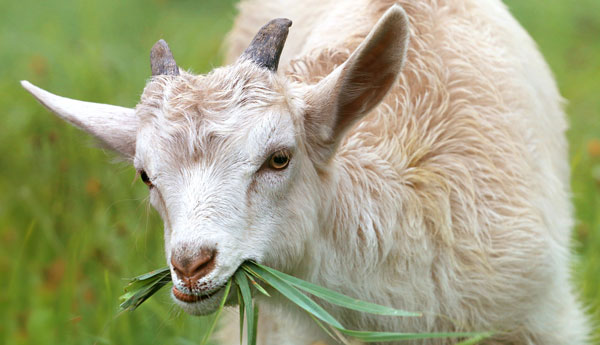
Owning goats is all well and good, but how do you keep the critters fed? Sure they’re browsers, but there’s more to keeping them alive and nourished than simply turning them loose in scrub brush. What happens when the forage runs low? Or if a cold winter dumps feet of snow on top of it? Here’s a general idea of what to feed your cloven-hoofed friends when the natural food outdoors simply won’t suffice.
Hay vs. Straw
First off, let’s clear up a misconception I see a lot of first-time farmers make. Straw is not hay, and hay is not straw. Straw consists of dried stalks of cereal plants AFTER the grains have already been removed. Hay is any form of grass, legume (think alfalfa or clover) or herbaceous plants (in some rare cases, even rye or barley with the grains still on), that has been cut and dried to use as animal fodder. What this means is that straw has absolutely no nutritional value, and thus should not be used interchangeably with hay as food. The nutritional deficits it causes when used as the sole feed item can lead to a host of diseases. It can also be used as bedding, though I prefer to just use waste hay that the goats have already spilled on the floor.
How do you tell the difference, or the quality, you ask? After all, low quality hay has barely any more nutritional value than straw, so buying good quality is essential. Check for the ratio of leaves to stems–good hay will have a high one. Next, dig a little into the interior of the bale and see if there is any green color. While the sun often bleaches the bale’s exterior yellow, the inside will retain the original color. Green can indicate such treats as alfalfa, and is just an indicator of high-quality hay in general. If the hay IS green on the outside, even better! Finally, ensure the individual pieces of hay have a good amount of flexibility to them, and that the bale is free of dirt and mold.
Straw on the other hand, will almost always be bleached yellow, lack any leaves, and will snap when bent, instead of flexing. While you can mix it in with a goat’s diet just for roughage, truth is good hay will supply enough roughage on its own, meaning you should never need to feed goats straw.
Grain
Grain is not a necessary part of a goat’s diet, however for goats in cold areas who need to put on some insulating weight, and goats producing dairy, it can be a good idea. It can also be used as a cheaper alternative to hay, to stretch your hay supply when money is tight. Never fully replace hay with grain, however, as goats need the roughage found in hay to keep their rumens healthy.
Prior to breeding season, try to mix in a half-pound to a pound of grain for your ewes per day, in a process called flushing. The increase in weight gain they sustain can help their fertility and ovulation rates, making a successful breeding season more probable. Lactation and nursing is another traditional time to feed ewes grains, as rearing their kids puts them under a greater level of nutritional stress. Finally, creep feeding–the supplemental feeding of kids to speed their growth–is another common use for grain. Grains such as cracked corn, soybean or rolled oats are best, as they provide high sources of protein.
I hope this has given a clear idea of what to feed your goats when natural sources of forage simply aren’t cutting it. Stay tuned for more on everyone’s favorite ruminants!
A humble homesteader based in an undisclosed location, Lars Drecker splits his time between tending his little slice of self-sustaining heaven, and bothering his neighbors to do his work for him. This is mainly the fault of a debilitating predilection for fishing, hunting, camping and all other things outdoors. When not engaged in any of the above activities, you can normally find him broken down on the side of the road, in some piece of junk he just “fixed-up.”

John says
I raised goat for 15 years and had to stop when I could no longer lift a bag of feed. Goats, over all, are not much trouble. Good feed supply (to include hay – recommend Sudan, pellet sheep and goat feed (14% protein is fine), and grass land. Feeding grass and hay only; you will need a LOT of land. Watch the goats, they eat low to the ground where the grass is tender. When it gets tall, it gets tough and they won’t eat it. Be prepared to mow. Ready supply of clean water. Goats don’t drink often but will drink a lot.
Goats can take cold and they can take being wet. Young goats cannot take wet and cold at the same time – it produces dead goats. If you build a barn, make sure it has good ventilation even in winter. Stirring up the dust in the barn will make animals sick. Air needs to move through to get rid of the dust.
Get a good book on goats. Some things are very normal, others are not. A good book will explain things to watch for, how to care for goats (like trimming the feet), worming the goats, etc.
Get a good book on goat health and diseases. If you have deer in your area, watch for pink eye. Goats with dark faces are less prone to pink eye… the flies have more trouble finding black eyes in a dark face. Easily treated but you have to recognize it before real damage is done. Also, neutered males are more subject to kidney stones.
I DO NOT recommend de-horning a goat. Their horns are not as dangerous as a large cow’s and make an excellent handle to catch and hold them. Goats for show must be de- horned so there’s not much choice there.
I stopped giving my goats Tetanus shots because I had too many develop and abscess at the shot site. Never had a goat get Tetanus.
You will need GOOD fencing! Goats can jump a 5 foot fence. Suggest a hot wire at the top and may need another one about knee high to keep the goats from rubbing on the fence (to scratch) and knocking your fence over.
A bunch of baby goats (kids) jumping around (it’s called “capering”) is a ball! A large pile of logs or large rocks is a wonderful toy for goats of all ages. Rough rocks will help to keep their feet trimmed, saving you some work.